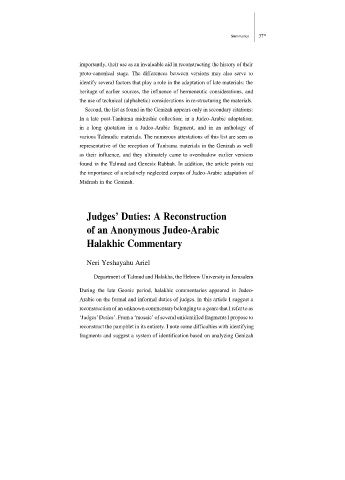Page 245 - GQ-9
P. 245
Summaries 37*
importantly, their use as an invaluable aid in reconstructing the history of their
proto-canonical stage. The differences between versions may also serve to
identify several factors that play a role in the adaptation of late materials: the
heritage of earlier sources, the influence of hermeneutic considerations, and
the use of technical (alphabetic) considerations in re-structuring the materials.
Second, the list as found in the Genizah appears only in secondary citations:
In a late post-Tanhuma midrashic collection; in a Judeo-Arabic adaptation;
in a long quotation in a Judeo-Arabic fragment, and in an anthology of
various Talmudic materials. The numerous attestations of this list are seen as
representative of the reception of Tanhuma materials in the Genizah as well
as their influence, and they ultimately came to overshadow earlier versions
found in the Talmud and Genesis Rabbah. In addition, the article points out
the importance of a relatively neglected corpus of Judeo-Arabic adaptation of
Midrash in the Genizah.
Judges’ Duties: A Reconstruction
of an Anonymous Judeo-Arabic
Halakhic Commentary
Neri Yeshayahu Ariel
Department of Talmud and Halakha, the Hebrew University in Jerusalem
During the late Geonic period, halakhic commentaries appeared in Judeo-
Arabic on the formal and informal duties of judges. In this article I suggest a
reconstruction of an unknown commentary belonging to a genre that I refer to as
‘Judges’ Duties’. From a ‘mosaic’ of several unidentified fragments I propose to
reconstruct the pamphlet in its entirety. I note some difficulties with identifying
fragments and suggest a system of identification based on analyzing Genizah

